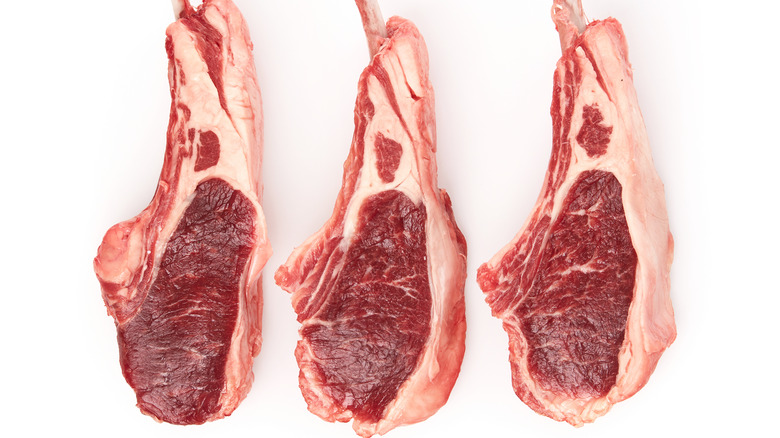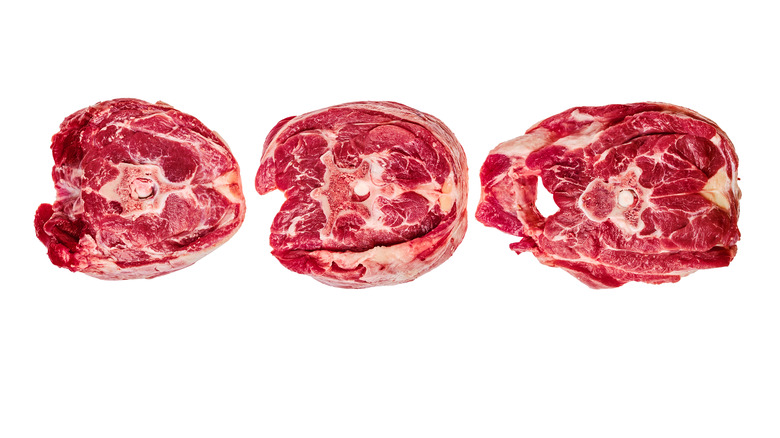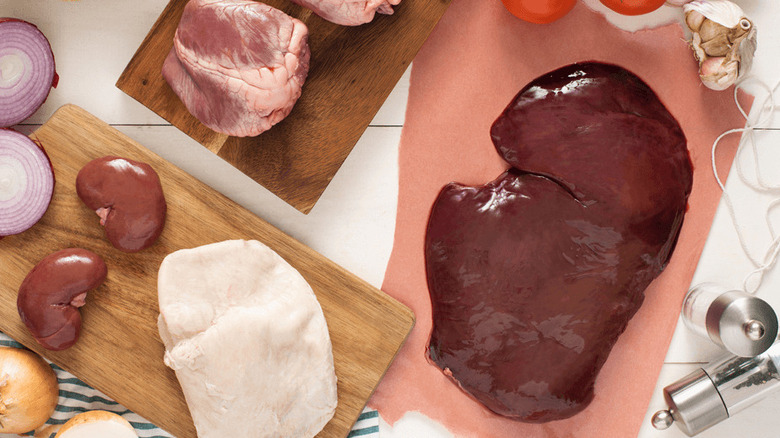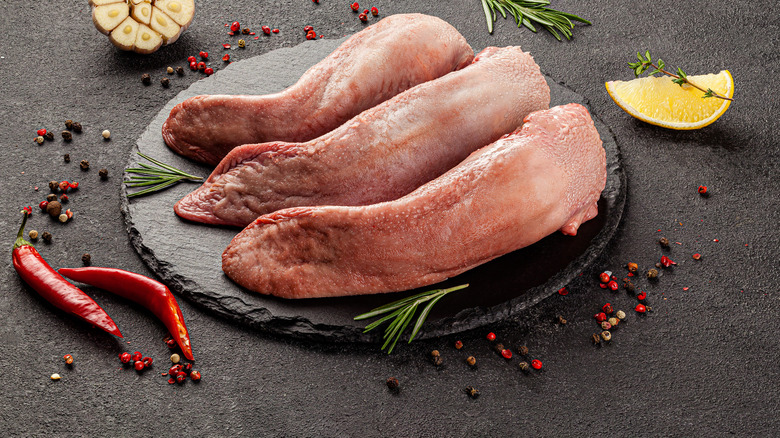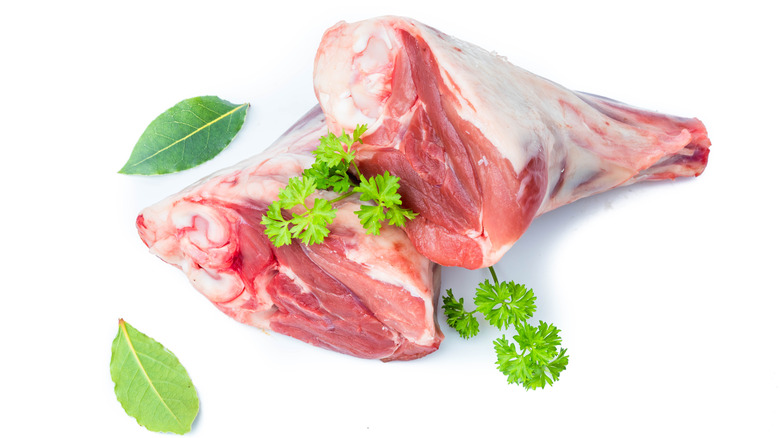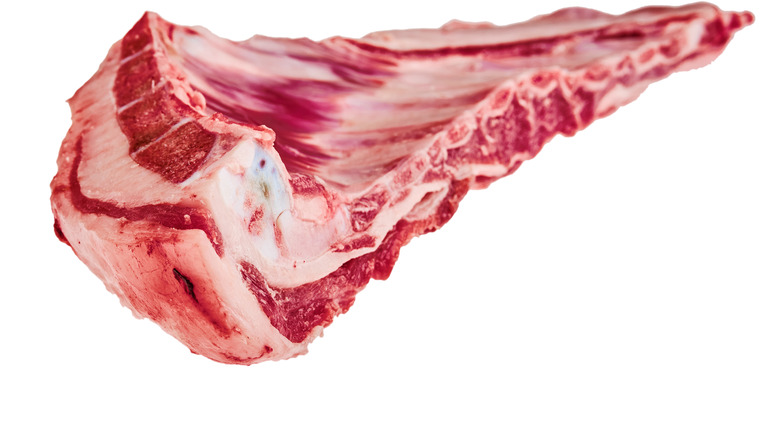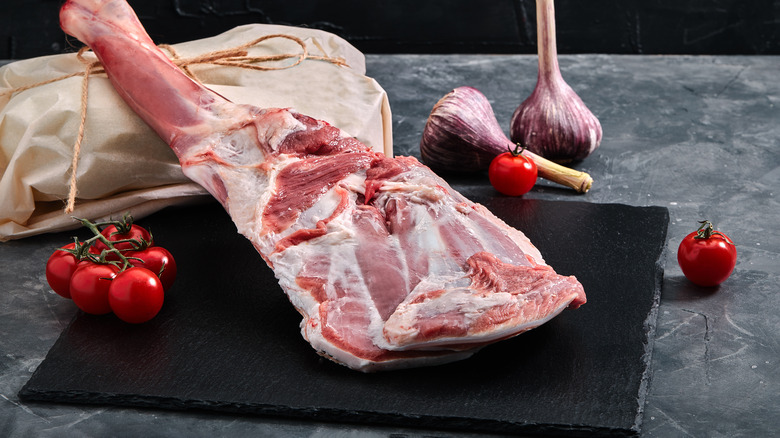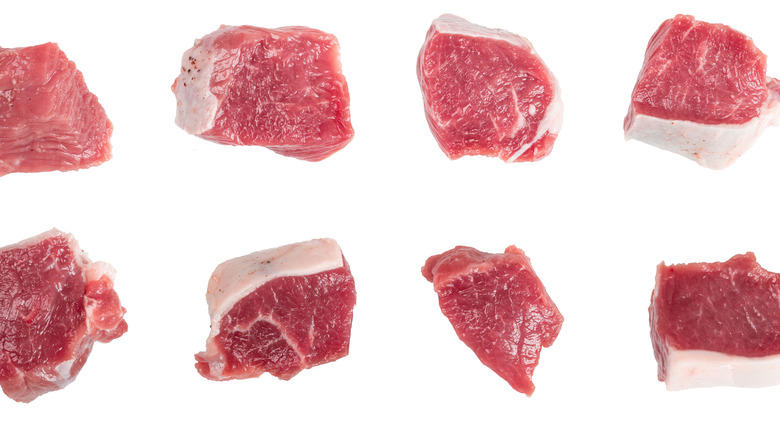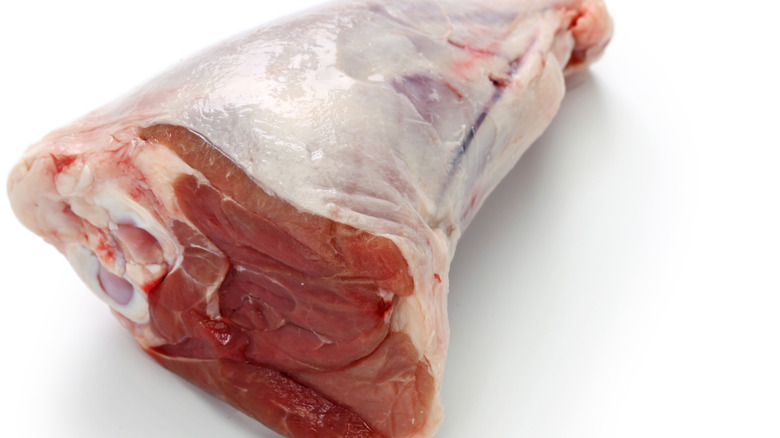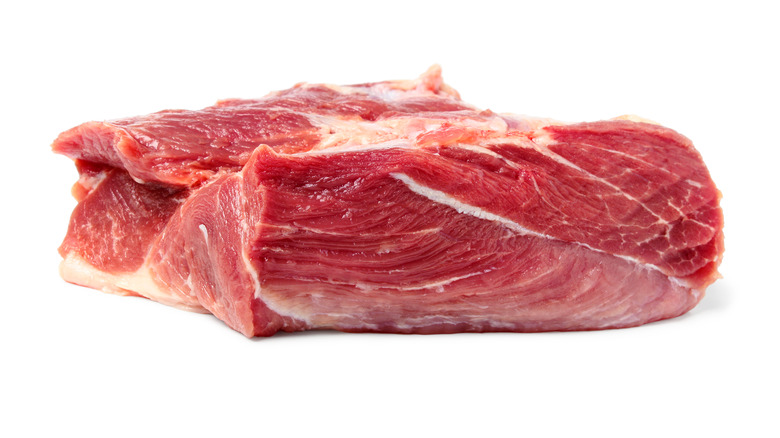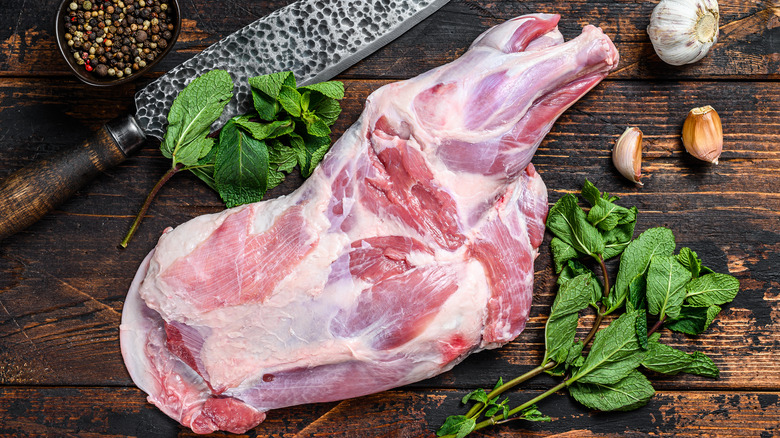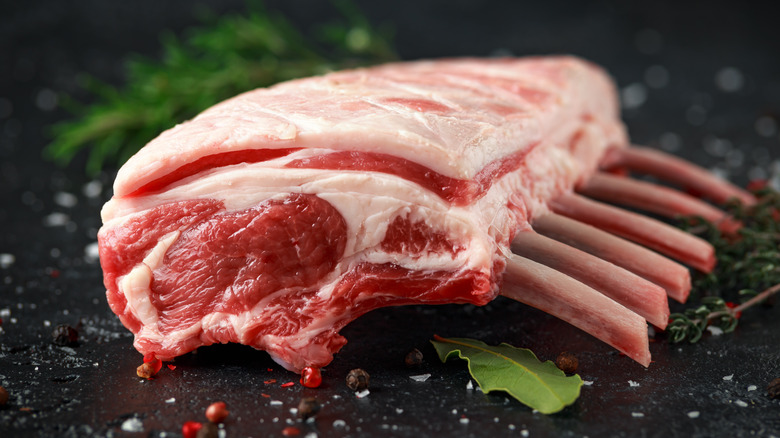Every Cut Of Lamb, Ranked Worst To Best
Since humans have been eating lamb for over 10,000 years, we've gotten pretty good at learning how to cook it. And, thanks to holidays like Easter and Passover, lamb is popular for celebrations and everyday meals. You may be wondering if there is a culinary difference between lamb and sheep, similar to the distinction between veal and beef. A lamb is a juvenile sheep up to 12 months in age, while a more mature sheep of around two years old is considered mutton (via RecipeTips.com). Lamb meat is smaller in size and milder compared to the more pronounced flavor of mutton.
Even if you're not stoking the coals under an entire roasted lamb for Greek Easter this year, it's certainly good to know all the various cuts of lamb available to you. While leg of lamb and lamb lollipops are probably somewhere in your vocabulary, there's much more to lamb than those cuts. Here's a list of every cut of lamb, ranked worst to best, although they all taste pretty good if you know how to cook them!
12. Flank
When discussing the various cuts of lamb, there's a specific butcher lingo that is helpful to understand. Butchers use the terms primal, subprimal, and market-ready when referring to an animal's body. The five major primal sections of lamb are the shoulder, the breast, the rib, the loin, and the leg (via Vincent's Meat Market). These larger sections then get broken down into subprimal before being divided into smaller market-ready cuts. For example, flank is a subprimal cut of the loin located on the belly of the lamb underneath the loin toward the hind legs.
Though fat usually brings out a good, meaty flavor, lamb flank is tough, with less meat than beef flank, which is often cooked as a steak. Instead, it is common for lamb flank to be made into ground meat (via RecipeTips). Ground lamb can be used in a variety of dishes, including lamb burger patties or a hearty lamb ragu sauce. Most often, lamb flank is made tender in long-simmered curries, stews, or slow roasts, which allow the tough meat to cook long enough to become tender.
11. Neck
Since the neck contains an abundance of frequently used connective tissues and muscles, it's a tough cut that's also packed with plenty of flavor (via Australian Lamb). A butcher can cut the lamb's neck with or without the bone. With the bone, the cut would be considered a neck rosette or neck chop, which, according to Australian Lamb, becomes flavorful and tender when slow-cooked. Boneless cuts of the neck, such as the neck filet roast, should also be simmered to break down the mass of tissues.
Although they take time and effort to cook, lamb neck cuts are amongst the cheapest parts of lamb, according to Boston-based chef Tony Maws. Selecting a lamb neck cut can make for a flavorful stew if you've got the time to braise or slow-cook. Consider braising the lamb in red wine and serving it with seasonal, wholesome veggies for an aromatic and comforting meal.
10. Offal
If you're a picky eater or a bit squeamish, the thought of lamb guts might seem unappetizing. However, many culinary experts and meat eaters know that offal, which refers to the various organs of an animal that are typically discarded, is packed with flavor and nutrients (via Today's Dietitian).
To prepare offal, ensure that all pieces are thoroughly cleaned before cooking. According to Beef + Lamb New Zealand, the liver is the simplest to cook as it can be pan-fried with herbs. As might be expected, the kidneys are pretty gamey, and like the liver, it wouldn't hurt to coat them in a bit of flour first for a nice crust. Beef + Lamb New Zealand suggests cooking the kidneys quickly over high heat to avoid them getting too dry or tough.
Don't let the idea of handling lamb brains freak you out — after a soak and a clean, they can be seared or ground up, resulting in rich, creamy texture that's quite appealing. Since they're so silky, it's common for them to be boiled, breaded, and deep-fried for a dish that's crispy outside and moist inside (via Eat, Little Bird).
Although it can be eaten raw, the lamb heart is fairly tough as a working muscle, so you may want to chop it and grill it. The tripe, or stomach of the animal, is spongey and flavor-absorbent, working well in stews. Finally, the sweetbreads, which refer to the pancreas and thymus glands, are considered a delicacy according to Great British Chefs. After a thorough soak and clean, the sweetbreads can be pan-fried or grilled, resulting in a soft and creamy texture.
9. Tongue
After reading about lamb brains and hearts, the concept of eating a lamb's tongue shouldn't be too shocking. Great British Chefs even noted that tongue boasts a meatier and more palatable taste than other offal. In fact, when cooked properly, the tongue is incredibly tender, with a melt-in-your-mouth texture. Because of this, the lamb's tongue is widely enjoyed, packed with immunity-boosting nutrients like zinc, iron, and B-12 vitamins (via Food Republic). Technically offal, lamb tongue not only tastes great, but the idea of using the entire lamb is also far more environmentally ethical than simply tossing away the parts you're uncomfortable with.
Food Republic cites that after poaching and peeling off the tongue's outer layer, it can be grilled like any other meat. Great British Chefs suggest brining the tongue in salt and cooking it with various vegetables. You can also slice the tongue thinly like deli meat for delicious sandwiches.
8. Foreshank
Foreshank refers to the bone-in cut of lamb from the lower portion of the lamb's front legs (via Marx Imports). Since the legs are a body part that the lamb uses often, the foreshank is a very muscley, tough cut packed with lots of connective tissues. Similar to other lamb cuts packed with connective tissues, cooking the lamb for an extended period of time in moist heat will allow the meat to tenderize. According to blogger Anna Cavitt Fisher, when these tougher meats are cooked in such a way, the large amounts of collagen in the muscles turn to gelatin, making the meat tender and silky as it simmers.
Another great part about this cut is that the meat surrounds a marrow bone. The marrow located within this bone breaks down during cooking, adding a rich depth of flavor to the final dish. While the meat can be shredded from the bone, most recipes will call for the bone to remain attached for presentation purposes.
7. Breast
A lamb breast cut comes from the belly of the lamb. According to Simply Beef & Lamb, the lamb breast is one of the fattier cuts of lamb, but the fat typically comes off as the breast cooks and can be discarded. While this description might sound unappealing — don't be fooled. When slow-cooked, the cut will undergo a transformation, becoming crispy on the outside and mouthwateringly tender on the inside.
A whole bone-in lamb breast can be roasted, braised, or stuffed (via RecipeTips.com). According to butcher Justin Williams, the breast can be cut off of the lamb's spare ribs, and though it is similar to that of a pig's belly, it's less meaty. He cites that it still packs in an incredible flavor and can even be cured to make lamb bacon! Sure, pork bacon is fatty and delicious, but lamb bacon is smoky, kosher, and halal-friendly (via Food Republic).
6. Leg
A popular cut of lamb that graces the tables of many Easter dinners and holiday celebrations is the leg of lamb. This cut can be boneless or bone-in and refers to the meatier, upper portion of the animal's hind legs. While various cuts are available from all four lamb legs, they all contain varying amounts of meat, fat, and muscle.
Leg of lamb typically weighs between 6 and 10 pounds, according to MasterClass, and choosing to keep the bone in or out is a decision that really only affects the presentation or appearance of the meat. However, Serious Eats has a different opinion. They believe that a boneless leg of lamb is both easier to carve and lighter in weight, making it less of a hassle to remove from the oven. That being said, the leg is a very popular cut of lamb as it is large, tender, versatile, and great roasted with vegetables and seasoned with garlic or rosemary.
5. Sirloin
The lamb sirloin refers to the area directly behind the loin and in front of the lamb's hind leg. It is a tender piece of meat and can be sold and cooked in a variety of different ways. The lamb sirloin can be sold attached to the upper portion of the lamb leg in some instances, or it can be sold as a boneless roast or cut into steaks. It's a very versatile cut of lamb, which makes it popular to eat.
Grilling the lamb sirloin as a steak is a wonderful way to enjoy its tender, meaty flavor. Since the sirloin of a lamb is fairly small in size, it doesn't take terribly long to cook, and it is also easy to prepare. According to butcher Lupin Midlin of Fleishers Craft Butchery, slow-roasted lamb sirloin is wonderfully tender when sliced thin, and perfect for sandwiches.
4. Hindshank
Since lambs use their hind legs so often, they carry a fair amount of meat. Marx Imports states that the meat on a hindshank is lean and typically sold on the bone. Since the hindshank is packed with lots of tough tendons, gourmet food company Marky's suggests cooking this cut slowly and adequately to avoid having a chewy, tough piece of meat.
So, what's the best cooking method to tackle this delicious but challenging cut of lamb? The answer is that lamb hindshank is best when braised in a flavorful liquid, as the necessary moisture helps it become tender and succulent to eat. You can also try pressure-cooking or slow-cooking the hindshank if braising isn't your thing, so long as you ensure plenty of moisture while the lamb cooks. To upgrade the flavors, be sure to cook the lamb hindshank with aromatics such as garlic, rosemary, cinnamon, or citrus.
3. Loin
The lamb loin can also be called the saddle, which should give you a good idea of its location on the lamb (it's where a saddle would go if you decide to take a ride on a lamb). Depending on whether you'd like a bone-in loin roast or a boneless loin roll, you can choose to have this cut with the bone or without. Keeping the bone in the loin cut can affect the flavor and cooking time of the lamb. For example, to preface their bone-in lamb loin roast recipe, This Old Farm notes that while a bone-in loin will take longer to cook, it'll provide some bonus flavor that you wouldn't get from a boneless roast.
The loin is a very tender cut of lamb, meaning that it has very little fat and a whole lot of flavor. You can also purchase a loin chop, which can be grilled or barbecued into a boldly flavored, juicy steak (via Meat & Cleaver). When cutting the loin into chops, butcher Justin Williams cites that because the layer of fat is mainly on the outside, make sure to render the fat during cooking. This method will give the meat a crispy exterior and a moist interior. Since there isn't a lot of fat on the loin, slow-cooking isn't necessary as it is for many other cuts. In fact, the loin's tenderness makes it one of the most desirable cuts of lamb.
2. Shoulder
The shoulder of the lamb is a highly desirable cut, though it contains plenty of tough muscle fibers and tendons that require long cooking times and lots of heat. The lamb shoulder chop is also one of the less expensive cuts of lamb, even though it tends to be larger than others like rib or loin chops (via Food52).
When butchering a whole lamb, expert butcher Justin Williams tells Bon Appétit that the shoulder cut begins after the fifth or sixth lamb rib, and it can be sold with or without the bone. This can yield bone-in steaks of around an inch in thickness, or a boneless shoulder can turn into a sizable roast. For the roast, Williams suggests searing each side after tying the roast up. Food Network also cites that it is customary to tie large cuts of meat like the shoulder before roasting to ensure even cooking.
1. Ribs
Of course, the ribs are the number one cut of lamb. The elegant crowd-favorite lamb chops and rack of lamb come from the rib cuts. According to Cooks Illustrated, cuts from the rib, including rack of lamb and rib chops, contain less fat than other lamb cuts and taste sweeter and milder.
A rack of lamb refers to the full set of eight ribs with loin meat attached (via AmazingRibs.com). It is common for butchers to "french" a rack of lamb ribs, which means removing the meat from the tip of the bone to expose the bone for an appealing presentation (via Serious Eats). If you've seen lamb lollipops at a fancy restaurant, those are lamb rib chops. Lamb rib chops are so favored because their fat content makes a marbled, juicy, tender finished chop after cooking — if done properly. Like many other lamb cuts, the ribs can turn out unpleasantly tough and chewy if not cooked correctly. Blogger Simply Recipes makes their rack of lamb by roasting it in the oven until it comes out tender and rare or medium-rare. Since lamb ribs and rack of lamb are on the more expensive side, you'll want to ensure that you don't ruin their silky texture by overcooking them!
